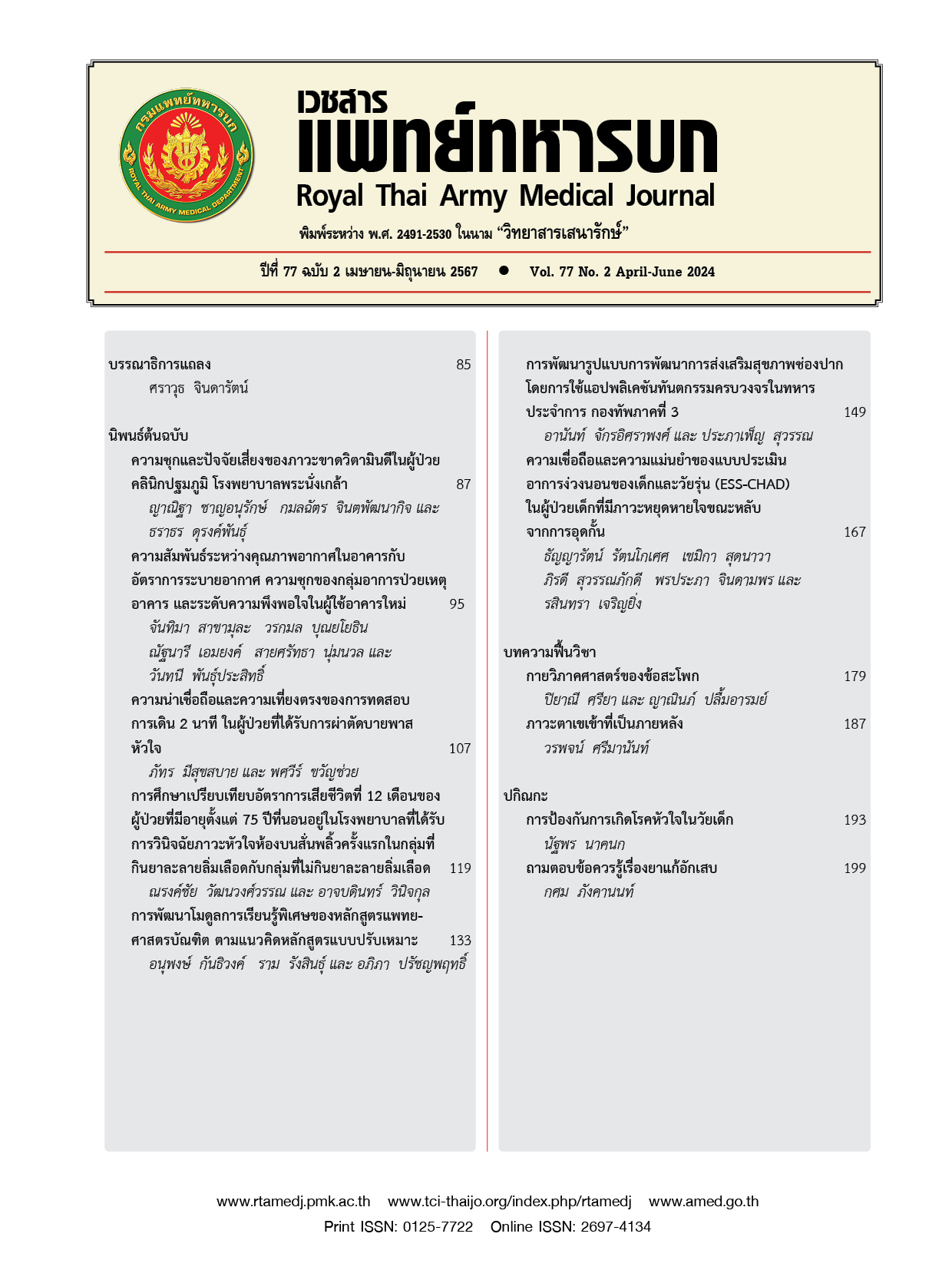การศึกษาเปรียบเทียบอัตราการเสียชีวิตที่ 12 เดือนของผู้ป่วยที่มีอายุ ตั้งแต่ 75 ปี ที่นอนอยู่ในโรงพยาบาลที่ได้รับการวินิจฉัยภาวะหัวใจห้องบนสั่นพลิ้วครั้งแรกในกลุ่มที่กินยาละลายลิ่มเลือดกับกลุ่มที่ไม่กินยาละลายลิ่มเลือด
Main Article Content
บทคัดย่อ
ที่มาและความสำคัญ ภาวะหัวใจห้องบนสั่นพลิ้วครั้งแรกเพิ่มความเสี่ยงในการเกิดโรคหลอดเลือดสมองซึ่งทำให้เกิดทุพพลภาพ และอัตราการเสียชีวิตที่เพิ่มขึ้น ถึงกระนั้นประโยชน์ของการเริ่มยาละลายลิ่มเลือดเร็วตั้งแต่ช่วงนอนอยุ่ในโรงพยาบาล เพื่อป้องกันโรคหลอดเลือดสมองในผู้สูงอายุที่เข้ารับการรักษาในโรงพยาบาลด้วยสาเหตุอื่นที่ไม่ใช่จากโรคหัวใจยังเป็นที่ถกเถียงกันในปัจจุบัน วัตถุประสงค์ เพื่อศึกษาผลของยาละลายลิ่มเลือดต่ออัตราการเสียชีวิตที่ 12 เดือนในผู้ป่วยที่มีอายุตั้งแต่ 75 ปีที่เข้ารับการรักษาในโรงพยาบาลและได้รับการวินิจฉัยภาวะหัวใจห้องบนสั่นพลิ้วครั้งแรก วิธีดำเนินการ ศึกษาแบบ retrospective cohort study ในผู้ป่วยอายุตั้งแต่ 75 ปีขึ้นไป ที่ได้เข้ารับการรักษาในโรงพยาบาลศิริราชด้วยสาเหตุอื่นที่ไม่ใช่จากโรคหัวใจตั้งแต่ปี พ.ศ. 2546-2562 ผลการวิจัย มีผู้ป่วยทั้งหมด 216 ราย ประกอบด้วย 24 รายในกลุ่มที่ได้รับยาละลายลิ่มเลือด และ 192 รายที่ไม่ได้รับยาละลายลิ่มเลือด ยาละลายลิ่มเลือดที่ผู้ป่วยได้รับส่วนใหญ่เป็น warfarin (91.7%) Hazard ratio ของอัตราการเสียชีวิตที่ 12 เดือนเป็น 0.33 (95% confidence interval 0.150.75-; p-value 0.08) คำนวณ post-hoc power ได้ 84% ที่ alpha 0.05 อย่างไรก็ตามผู้ป่วยส่วนใหญ่ (96.4%) เสียชีวิตจากสาเหตุอื่นที่ไม่ใช่โรคหัวใจ สรุป ผู้ป่วยที่สูงอายุที่เข้ารับการรักษาในโรงพยาบาลและได้รับการวินิจฉัยภาวะหัวใจห้องบนสั่นพลิ้วครั้งแรกเสียชีวิตจากสาเหตุอื่นที่ไม่ใช่โรคหัวใจเป็นสาเหตุหลัก การเริ่มยาละลายลิ่มเลือดในผู้ป่วยกลุ่มดังกล่าวถูกจำกัดด้วยโรคหรือโรคประจำตัวของผู้ป่วยเอง แต่ถึงอย่างไรก็ตามการตระหนักถึงการให้ยาละลายลิ่มเลือด เพื่อป้องกันโรคหลอดเลือดสมองยังมีความจำเป็น การศึกษาเพิ่มเติมแบบ prospective study จึงเป็นส่วนสำคัญที่ช่วยบอกถึงช่วงเวลาที่เหมาะสมในการเริ่มยาละลายลิ่มเลือด โดยเฉพาะ warfarin เพื่อให้เกิดประโยชน์สูงสุดในการป้องกันโรคหลอดเลือดสมองและลดโอกาสการเกิดภาวะเลือดออก
Downloads
Article Details

อนุญาตภายใต้เงื่อนไข Creative Commons Attribution-NonCommercial-NoDerivatives 4.0 International License.
บทความในวารสารนี้อยู่ภายใต้ลิขสิทธิ์ของ กรมแพทย์ทหารบก และเผยแพร่ภายใต้สัญญาอนุญาต Creative Commons Attribution-NonCommercial-NoDerivatives 4.0 International (CC BY-NC-ND 4.0)
ท่านสามารถอ่านและใช้งานเพื่อวัตถุประสงค์ทางการศึกษา และทางวิชาการ เช่น การสอน การวิจัย หรือการอ้างอิง โดยต้องให้เครดิตอย่างเหมาะสมแก่ผู้เขียนและวารสาร
ห้ามใช้หรือแก้ไขบทความโดยไม่ได้รับอนุญาต
ข้อความที่ปรากฏในบทความเป็นความคิดเห็นของผู้เขียนเท่านั้น
ผู้เขียนเป็นผู้รับผิดชอบต่อเนื้อหาและความถูกต้องของบทความของตนอย่างเต็มที่
การนำบทความไปเผยแพร่ซ้ำในรูปแบบสาธารณะอื่นใด ต้องได้รับอนุญาตจากวารสาร
เอกสารอ้างอิง
Wattanawongwon N, Winijkul A. Effect of oral anti-coagulant on 12-month overall mortality rate in admitted elderly patient with newly diagnosed atrial fibrillation and atrial flutter. J Arrhythmia. 2023;39(Suppl. 2):75.
Phrommintikul A, Detnuntarat P, Prasertwitayakij N, Wongcharoen W. Prevalence of atrial fibrillation in Thai elderly. J Geriatr Cardiol. 2016;13(3):270-3.
Marx N, McGuire DK, Perkovic V, Woerle HJ, Broedl UC, von Eynatten M, et al. Composite Primary End Points in Cardiovascular Outcomes Trials Involving Type 2 Diabetes Patients: Should Unstable Angina Be Included in the Primary End Point? Diabetes Care. 2017;40(9):1144-51.
Fauchier L, Villejoubert O, Clementy N, Bernard A, Pierre B, Angoulvant D, et al. Causes of Death and Influencing Factors in Patients with Atrial Fibrillation. Am J Med. 2016;129(12):1278-87.
Hindricks G, Potpara T, Dagres N, Arbelo E, Bax JJ, Blomström-Lundqvist C, et al. ESC Scientific Document Group. 2020 ESC Guidelines for the diagnosis and management of atrial fibrillation developed in collaboration with the European Association for Cardio-Thoracic Surgery (EACTS): The Task Force for the diagnosis and management of atrial fibrillation of the European Society of Cardiology (ESC) Developed with the special contribution of the European Heart Rhythm Association (EHRA) of the ESC. Eur Heart J. 2021;42(5):373-498.
Joglar JA, Chung MK, Armbruster AL, Benjamin EJ, Chyou JY, Cronin EM, et al. Peer Review Committee Members. 2023 ACC/AHA/ ACCP/HRS Guideline for the Diagnosis and Management of Atrial Fibrillation: A Report of the American College of Cardiology/American Heart Association Joint Committee on Clinical Practice Guidelines. Circulation. 2024;149(1):e1-e156.
Ekerstad N, Karlsson T, Soderqvist S, Karlson BW. Hospitalized frail elderly patients - atrial fibrillation, anticoagulation and 12 months’ outcomes. Clin Interv Aging. 2018;13:749-56.
Ohta M, Hayashi K, Mori Y, Sato H, Noto T, Kawahatsu K, et al. Impact of Frailty on Bleeding Events Related to Anticoagulation Therapy in Patients With Atrial Fibrillation. Circ J. 2021;85(3):235-42
Yamashita T, Akao M, Atarashi H, Ikeda T, Koretsune Y, Okumura K, et al. Effect of Polypharmacy on Clinical Outcomes in Elderly Patients With Non-Valvular Atrial Fibrillation - A Sub-Analysis of the ANAFIE Registry. Circ J. 2022;87(1):6-16.
Chen N, Alam AB, Lutsey PL, MacLehose RF, Claxton JS, Chen LY, et al. Polypharmacy, Adverse Outcomes, and Treatment Effectiveness in Patients >/=75 With Atrial Fibrillation. J Am Heart Assoc. 2020;9(11):e015089.
Raposeiras-Roubin S, Abu-Assi E, Paz RC, Rossello X, Barreiro Pardal C, Pinon Esteban M, et al. Impact of malnutrition in the embolic-haemorrhagic trade-off of elderly patients with atrial fibrillation. Europace. 2020;22(6):878-87.
Shinohara M, Wada R, Yano K, Akitsu K, Koike H, Kinoshita T, et al. Relationship between the nutritional status and safety and efficacy outcomes in atrial fibrillation patients aged 80 years and over receiving oral anticoagulants. J Cardiol. 2021;77(2):147-53.
Siu CW, Tse HF. Net clinical benefit of warfarin therapy in elderly Chinese patients with atrial fibrillation. Circ Arrhythm Electrophysiol. 2014;7(2):300-6.
Martin-Loeches I, Guia MC, Vallecoccia MS, Suarez D, Ibarz M, Irazabal M, et al. Risk factors for mortality in elderly and very elderly critically ill patients with sepsis: a prospective, observational, multicenter cohort study. Ann Intensive Care. 2019;9(1):26.
Ibarz M, Haas LEM, Ceccato A, Artigas A. The critically ill older patient with sepsis: a narrative review. Ann Intensive Care. 2024;14(1):6.
Walkey AJ, Quinn EK, Winter MR, McManus DD, Benjamin EJ. Practice Patterns and Outcomes Associated With Use of Anticoagulation Among Patients With Atrial Fibrillation During Sepsis. JAMA Cardiol. 2016;1(6):682-90.
Sogaard M, Skjoth F, Kjaeldgaard JN, Lip GYH, Larsen TB. Bleeding Complications in Anticoagulated Patients With Atrial Fibrillation and Sepsis: A Propensity-Weighted Cohort Study. J Am Heart Assoc. 2017;6(11):e007453.
Lip GY, Frison L, Halperin JL, Lane DA. Comparative validation of a novel risk score for predicting bleeding risk in anticoagulated patients with atrial fibrillation: the HAS-BLED (Hypertension, Abnormal Renal/Liver Function, Stroke, Bleeding History or Predisposition, Labile INR, Elderly, Drugs/Alcohol Concomitantly) score. J Am Coll Cardiol. 2011;57(2):173-80.
Bhave PD, Goldman LE, Vittinghoff E, Maselli J, Auerbach A. Incidence, predictors, and outcomes associated with postoperative atrial fibrillation after major noncardiac surgery. Am Heart J. 2012;164(6):918-24.
Joshi KK, Tiru M, Chin T, Fox MT, Stefan MS. Postoperative atrial fibrillation in patients undergoing non-cardiac non-thoracic surgery: A practical approach for the hospitalist. Hosp Pract (1995). 2015;43(4):235-44.
Bo M, Li Puma F, Badinella Martini M, Falcone Y, Iacovino M, Grisoglio E, et al. Effects of oral anticoagulant therapy in older medical in-patients with atrial fibrillation: a prospective cohort observational study. Aging Clin Exp Res. 2017;29(3):491-7.
Salih M, Abdel-Hafez O, Ibrahim R, Nair R. Atrial fibrillation in the elderly population: Challenges and management considerations. J Arrhythm. 2021;37(4):912-921.


